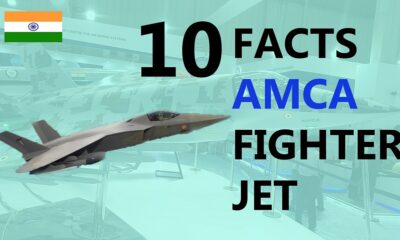Aviation
What makes Dassaults Rafale fighter jet so special?
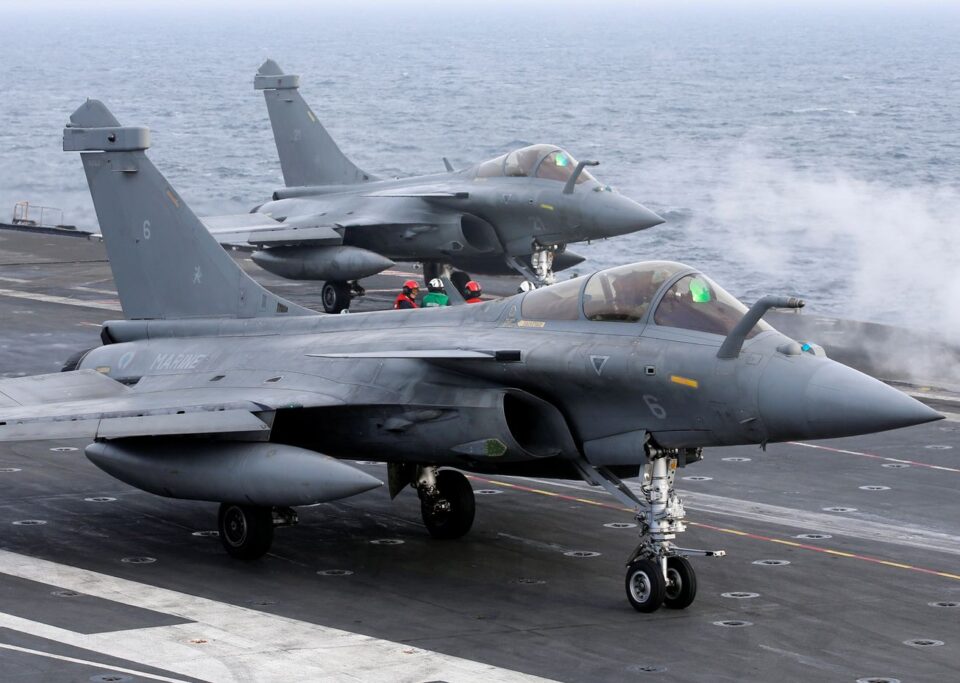
What makes Dassaults Rafale fighter jet so special? : Over the last decades, air forces have always been the first military component engaged in all crises or conflicts, from the Falklands to the Gulf, from Bosnia to Kosovo, from Afghanistan to Libya, and more recently Mali, the Central African Republic, Iraq and Syria.
Military aviation is undoubtedly the most strategic weapon today, both in terms of combat effectiveness and of critical technologies implemented.
In modern warfare, air dominance from day one is a must, so that air-to-ground and air-to-sea operations can be conducted safely and efficiently.
In the course of asymmetrical and counter-insurgency conflicts, the air arm also remains at the forefront of the military effort, its flexibility and firing power helping ensure that allied forces prevail.
The Rafale, a fully “Omnirole” fighter, is available in three variants:
- the Rafale C single-seater operated from land bases,
- the Rafale M single-seater for carrier operations,
- the Rafale B two-seater flown from land bases.
All three variants share a common airframe and a common mission system, the differences between naval and land versions being mainly limited to the undercarriage and to the arresting hook.
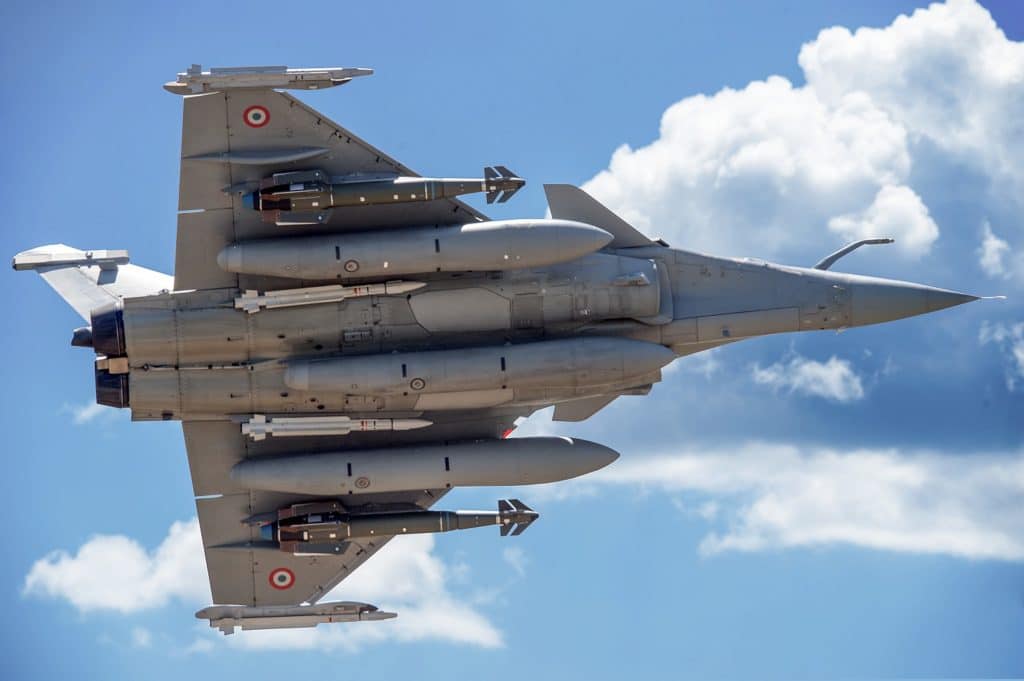
OMNIROLE BY DESIGN
When the Rafale programme was launched, the French Air Force and French Navy published a joint requirement for an omnirole aircraft that would have to replace the seven types of combat aircraft then in operation.
The new aircraft would have to be able to carry out a very wide range of missions:
- Air-defense / air-superiority,
- Anti-Access/Aera Denial,
- Reconnaissance,
- Close air support,
- Dynamic Targeting,
- Air-to-ground precision strike / interdiction,
- Anti-ship attacks,
- Nuclear deterrence,
- buddy-buddy refuelling.
A WIDE RANGE OF SMART AND DISCRETE SENSORS
What makes the essential difference is the Rafale’s “multi-sensor data fusion” process running on data provided by all the sensors of the aircraft.
In essence, the “multi-sensor data fusion” concept implemented into the Rafale allows the pilot to act as a true “tactical decision maker”, rather than being only a sensor operator.
The core of these enhanced capabilities of the RAFALE lies in a “Modular Data Processing Unit” (MDPU) incorporating “commercial off the shelf” (COTS) elements. It is composed of up to 19 flight “line-replaceable units” (LRUs), with 18 of them individually providing 50 times the processing power of a typical mission computer employed in previous generation fighters.
The MDPU is the cornerstone of the upgradeability of the Rafale. It allows a seamless integration of new weapons and new capabilities to maintain the warfighting relevance of the Rafale over the years as tactical requirements evolve, and as the computer industry keeps rolling out new generations of processors and software.
The “multi-sensor data fusion” provides a link between the battlespace surrounding the aircraft and the pilot’s brain with its unique ability to grasp the outcome of tactical situations and make sensible decisions.
things on the computing power of the MDPU to process data from the RBE2-AESA radar, the “Front Sector Optronic” (FSO) system, the SPECTRA EW system, the IFF, the MICA infrared seekers, and the data link.
It is a full automated process carried out in three steps:
- Establishing consolidated track files and refining primary information provided by the sensors,
- Overcoming individual sensor limitations related to wavelength / frequency, field of regard, angular and distance resolution, etc, by sharing track information received from all the sensors,
- Assessing the confidence level of consolidated tracks, suppressing redundant track symbols and decluttering the displays.
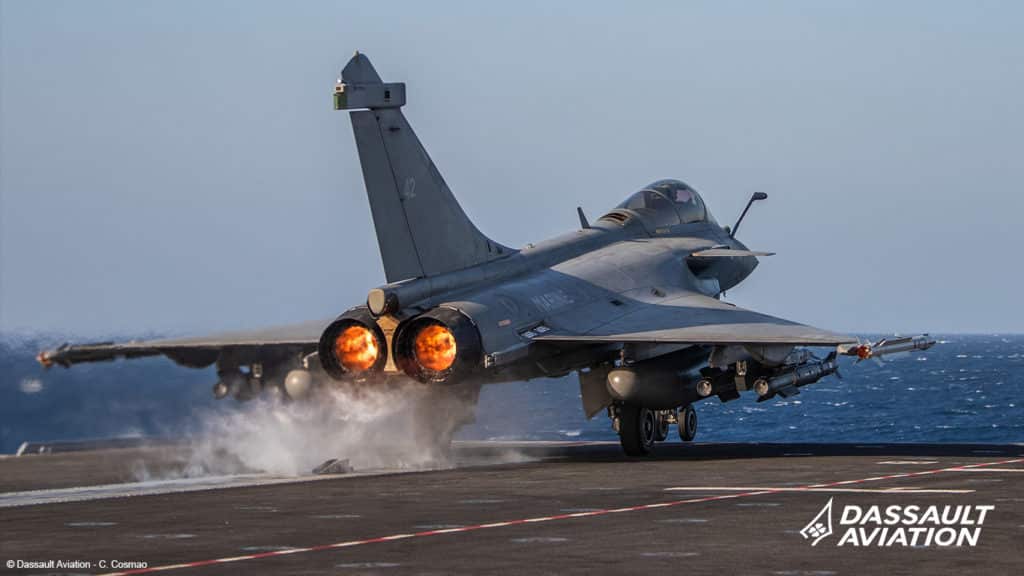
A FULLY OPTIMIZED AIRFRAME
The Rafale features a delta wing with close-coupled canards. In-house research in computational fluid dynamics has shown the specific benefits of close coupling between the wings and the canards: it ensures a wide range of centre of gravity positions for all flight conditions, as well as excellent handling throughout the whole flight envelope.
The close-coupled canards / delta wing configuration is key to the combat performance of the Rafale: even at high angle-of-attack, it remains fully agile, and its range performance in strike missions with heavy weapon loads is unmatched for such a compact design.
Read more : 12 things to know about Airbus A320 family
An advanced digital “Fly-by-Wire” (FBW) Flight Control System (FCS) provides for longitudinal stability and superior handling performance. The FCS is quadruple redundant with three digital channels and one separately designed analogue channel, with no mechanical back-up: design independence between channels is key to avoiding simultaneous anomalies on all channels.
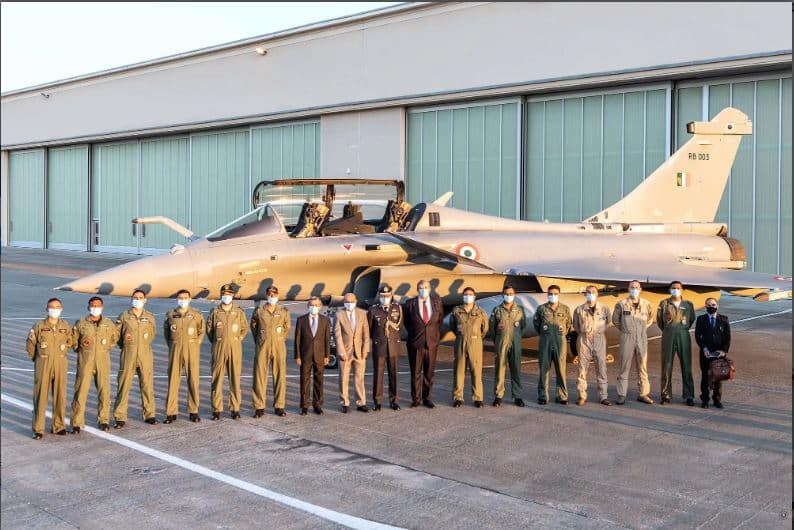
THE M88 – A NEW GENERATION ENGINE
The M88-2 is a new-generation turbofan engine offering a high thrust-to-weight ratio with easy maintainability, high despatch reliability and lower operating costs.
The M88-2 incorporates advanced technologies such as integrally bladed compressor disks (“blisks”), a low-pollution combustor with smoke-free emissions, single-crystal high-pressure turbine blades, ceramic coatings, and composite materials.
Read more : Is China’s COMAC C919 better than B737max and A319neo ?
The M88-2 power plant is rated at 10,971 lbs dry and 16,620 lbs with afterburner. It is equipped with redundant “Full Authority Digital Engine Control” (FADEC), which provides for carefree engine handling anywhere in the flight envelope: the throttle can be slammed from combat power to idle and back to combat power again, with less than three seconds from idle to full afterburner.
Launched in 2008, the M88 TCO (“Total Cost of Ownership”) programme was initiated to further improve engine durability and bring support costs down. Capitalizing on the ECO project, Safran Aircraft Engines was able to upgrade the high-pressure compressor and the high-pressure turbine of the M88-2: cooling is ameliorated and stronger components have been introduced, boosting durability by up to 50%. Life expectancy between overhaul has been considerably expanded for a number of modules, helping further minimise the impact of planned maintenance on engine availability.
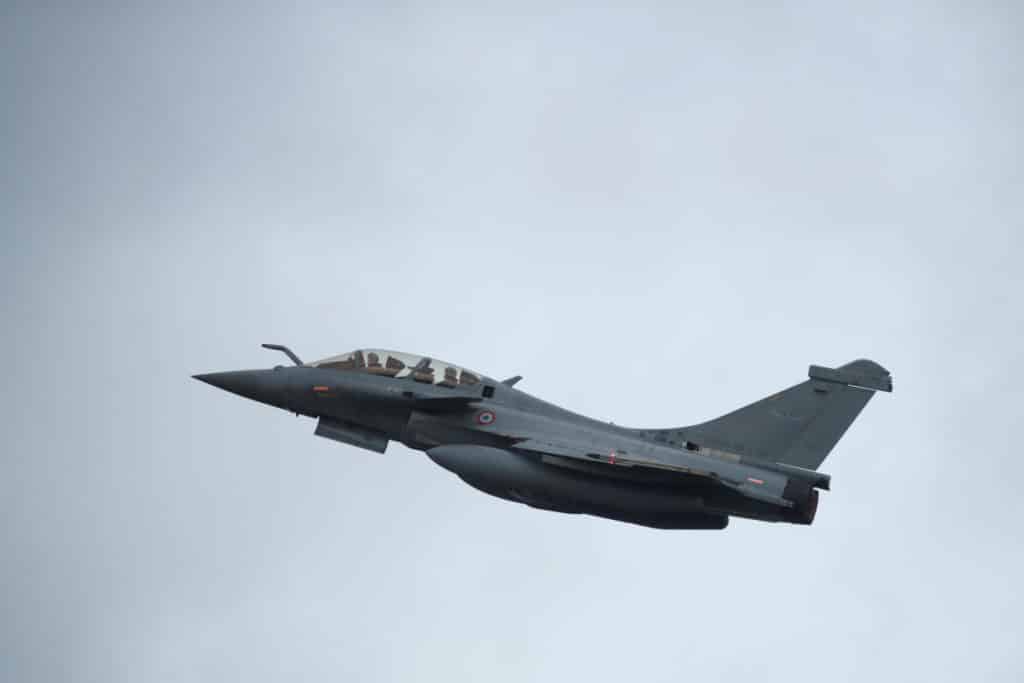
A UNIQUE MAN-MACHINE INTERFACE (MMI)
Dassault Aviation has developed a very easy to use pilot interface (MMI), combining the “Hands on Throttle and Stick” (HOTAS) control concept with touch screens. It relies on a highly integrated suite of equipment with the following capabilities:
- For short-term actions, head-up flying using a wide-field-of-view holographic “Head-up Display” (HUD),
- For medium and long-term actions, analysis of the tactical situation as a whole (the “big picture”), using a multi-image “Head-Level Display” (HLD). The HLD picture is focused at the same distance as the HUD picture to allow for fast eye transitions between head-up and head-down displays and the external world’s view,
- Management of system resources via the left and right color touch screens.
The comprehensive design of the cockpit provides for everything that aircrews can expect from an “OMNIROLE” fighter: a wide field of view at the front, on both sides, and at the rear, a superior agility, an increased G-protection with 29° tilted seats, and an efficient air conditioning system demonstrated under all climates.
RAFALE DEPLOYMENT HISTORY
Four batches of 13, 48, 59 and 60 aircraft have been ordered by the French MoD, totaling 132 aircraft for the French Air Force (63 Rafale B two-seaters and 69 Rafale C single-seaters) and 48 Rafale M naval single-seaters for the French Navy. Egypt, Qatar and India have signed contracts for respectively 24, 24 and 36 Rafales, bringing firm orders to 264 aircraft. By the end of April 2017, no less than 148 Rafales had been delivered to the Armée de l’Air and the French Navy while a further nine had been built for Egypt.
Capabilities are developed incrementally, and released in packages (“standards”). The first release (standard F1) featured only air-to-air capabilities. It became operational in 2004 with the French Navy on Rafales launched from the Charles de Gaulle nuclear aircraft-carrier during operation “Enduring Freedom”.
The second capability release (standard F2) entered service in the French Air Force and in the French Navy in 2006. It provided the Rafale with its true “Omnirole” capability for air-to-air and air-to-ground missions.
General characteristics
- Crew: 1 or 2
- Length: 15.27 m (50 ft 1 in)
- Wingspan: 10.90 m (35 ft 9 in)
- Height: 5.34 m (17 ft 6 in)
- Wing area: 45.7 m2 (492 sq ft)
- Empty weight: 10,300 kg (22,708 lb) (B)
9,850 kilograms (21,720 lb) (C)10,600 kilograms (23,400 lb) (M)
- Gross weight: 15,000 kg (33,069 lb)
- Max takeoff weight: 24,500 kg (54,013 lb)
- Fuel capacity: 4,700 kg (10,362 lb) internal for single-seater (C); 4,400 kg (9,700 lb) for two-seater (B)
- Maximum fuel: (C): 16,550 l (4,370 US gal; 3,640 imp gal) (5,750 l (1,520 US gal; 1,260 imp gal) internal + 2,300 l (610 US gal; 510 imp gal) in 2x conformal tanks + 8,500 l (2,200 US gal; 1,900 imp gal) in 5 drop tanks)
- Powerplant: 2 × Snecma M88-2 turbofans, 50.04 kN (11,250 lbf) thrust each dry, 75 kN (17,000 lbf) with afterburner
Performance
- Maximum speed: 2,223 km/h (1,381 mph, 1,200 kn) / Mach 1.8 at high altitude
1,390 km/h, 860 mph, 750 kn / Mach 1.1 at low altitude
- Supercruise: Mach 1.4
- Combat range: 1,850 km (1,150 mi, 1,000 nmi) on penetration mission with three tanks (5,700 L), two SCALP-EG and two MICA AAMs.
- Ferry range: 3,700 km (2,300 mi, 2,000 nmi) with 3 drop tanks
- Service ceiling: 15,835 m (51,952 ft)
- g limits: +9 −3.6 (+11 in emergencies)
- Rate of climb: 304.8 m/s (60,000 ft/min)
- Wing loading: 328 kg/m2 (67 lb/sq ft)
- Thrust/weight: 0.988 (100% fuel, 2 EM A2A missile, 2 IR A2A missile) version B
Source : Dassault Rafale

Aviation
South Korea Introduces Cutting-Edge MRO Center for F-35 and IAI

South Korea is set to make waves in the aerospace industry with the establishment of a cutting-edge Maintenance, Repair, and Overhaul (MRO) hub for F-35 fighter jets and IAI (Israel Aerospace Industries) aircraft.
Central to this initiative is the specialization in converting Boeing 777-ERSF, colloquially known as the “Big Twin,” from passenger to freighter configurations. Under the terms of the agreement, IAI will spearhead the conversion of six B777-300ER and B777-200LR aircraft annually, commencing in 2024. This strategic move is in response to the anticipated surge in demand for wide-body freighter aircraft capable of long-haul flights.
Furthermore, South Korea’s forward-looking vision extends beyond aircraft conversion, with plans to establish a Lockheed Martin F-35 maintenance, repair, and overhaul depot at Cheongju Air Base by 2027. This strategic move not only enhances the operational readiness of South Korea’s air force but also positions the nation as a regional hub for F-35 maintenance expertise.
In preparation for this expansion, thirty Republic of Korea Air Force (ROKAF) engineers and technicians are slated to undergo intensive maintenance training in the United States in 2025, a testament to South Korea’s commitment to fostering local expertise and talent.
IAI’s visionary approach to certification and collaboration underscores the potential for transformative change. With plans for the 777-300ERSF certification process set to unfold in Israel, followed by the rigorous scrutiny of regulatory agencies such as the US Federal Aviation Administration (FAA), the stage is set for the ‘Big Twin’ to soar to new heights of success.
In partnership with esteemed entities like STK and Incheon International Airport Corporation, this collaboration promises to unleash a wave of benefits, amplifying the resilience and competitiveness of the Korean aviation sector while catalyzing job creation and economic prosperity.
Aviation
Lockheed Martin Expresses Interest in Joining AMCA Project

Lockheed Martin, a leading global aerospace and defense company, is demonstrating its dedication to strengthening collaborations with India’s research, industry, and academic sectors. With its rich experience in the aerospace industry and renowned for building some of the world’s most advanced jets, Lockheed Martin is now exploring opportunities to contribute to India’s aerospace sector, potentially providing a significant boost to aerospace technology in the country.
Randy Howard, Vice President of Global Pursuits at Lockheed Martin Aeronautics, recently underscored their interest in exploring “advanced transfer of technology opportunities” with Indian partners, signaling a proactive approach towards fostering technological exchange and advancement in the aerospace domain.
India has been at the forefront of fighter jet development since the 1970s, having produced its own cost-effective fighter jets and combat helicopters, while continually upgrading to maintain competitiveness on a global scale.
Lockheed Martin stands as a dominant force in the aircraft industry, renowned for developing cutting-edge planes like the F35 and F22, some of the most advanced fighter jets globally. They’ve also contributed to projects like the South Korean KF21 aircraft for defense purposes through collaborations.
Now, Lockheed Martin has set its sights on India’s defense sector manufacturing processes, expressing interest in partnering with India on its most anticipated project, the Advanced Medium Combat Aircraft (AMCA), likely to be a 5th generation fighter jet for the Indian military.
Their proposed collaboration could involve a spectrum of advanced technologies, including the Auto Ground Collision Avoidance System (Auto GCAS), a life-saving technology that intervenes to prevent ground collisions, thus significantly enhancing flight safety for Indian pilots.
Lockheed Martin is extending its expertise to design and develop an indigenous cockpit for the F-21 fighter jets, which India is procuring. This collaboration with Tata also includes the development of fighter jet wings. Established in 2023, this partnership adopts a “Ground Floor Design” strategy aimed at equipping India with an in-depth comprehension of 5th-generation cockpit technology and Man-Machine Interface (MMI) systems.
As India’s Fighter jet program advances with finalized aircraft frame and engine prototypes, Lockheed Martin has expressed interest in joining the project. They see a groundbreaking opportunity in cooperative 5th Generation Fighter Development, potentially expediting the AMCA program’s progress through technology and expertise sharing.
Furthermore, Lockheed Martin is keen on collaborating on large-wing, jet-powered UAV platforms, which could enhance India’s unmanned aerial capabilities.
While discussions are ongoing, and specific collaboration details await finalization, this initiative represents a potentially transformative stride in India’s aerospace self-reliance journey and Lockheed Martin’s strategic engagement with the Indian market.
Aviation
Can Airline Seat Cushions Be Used As Life Jackets?

In the event of an aircraft ditching into water, there’s a common question: Can aircraft seats serve as an alternative to life jackets for flotation? The answer lies in understanding their respective functions.
While seat cushions can provide some buoyancy in water, they are not intended nor certified to function as life jackets. Their primary purpose is to offer cushioning for passengers during flight. On the other hand, life jackets are meticulously engineered to keep individuals afloat in water, equipped with buoyancy materials, secure straps, and reflective elements for visibility. They offer numerous advantages over mere cushions.
While a seat cushion might offer temporary assistance in staying afloat, it’s not a dependable substitute for a proper life jacket during an emergency. It’s crucial to utilize approved safety equipment when near bodies of water. A life jacket, designed to keep a person buoyant for extended periods, offers the rigidity needed for prolonged flotation and allows for easy movement of the arms to navigate effectively.
What fabric is used in aircraft seats?
Seats are meticulously designed to fulfill multiple purposes, ensuring passenger comfort, safety, and protection from unforeseen circumstances like fires and accidents. A typical design incorporates an aluminum frame with blocks of polyurethane foam affixed to it. Additionally, a layer of fire-resistant fabric, such as Kevlar or Nomex, is often applied over this framework, topped with a layer of cloth or leather.
Leather seats, while luxurious, are more expensive compared to traditional cloth seats. The majority of fabrics used in seat upholstery contain at least 90% wool fiber, with the remainder typically consisting of polyamide (nylon). Wool stands out as the primary fiber chosen for commercial airline seating fabric due to its desirable properties and suitability for such applications.
What is the lightest economy seat?
In recent times, airlines have been downsizing seat dimensions to accommodate more passengers, resulting in reduced cushion length and leg space. This contrasts with earlier times when airlines offered more generously cushioned seats and ample amenities.
According to Recaro Seats Company, their SL3710 model represents the lightest economy class seat available, weighing in at a mere 8 kg (17.6 lb.), setting a new standard in aircraft seating.
For individuals weighing more than 350 pounds, fitting into a standard economy-class seat can be a challenge due to the narrower dimensions. Economy seats, also referred to as “coach,” “standard,” or “main cabin” seats, typically range from about 40 to 48 centimeters in width, further emphasizing the need for more accommodating seating options.



